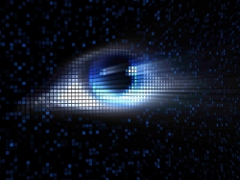A magazine where the digital world meets the real world.
On the web
- Home
- Browse by date
- Browse by topic
- Enter the maze
- Follow our blog
- Follow us on Twitter
- Resources for teachers
- Subscribe
In print
What is cs4fn?
- About us
- Contact us
- Partners
- Privacy and cookies
- Copyright and contributions
- Links to other fun sites
- Complete our questionnaire, give us feedback
Search:
An illusion of symmetry: Chunk it!

Glance down a busy street and I immediately recognise the things around me: people, shops, dogs, lamp-posts ...
How do we so quickly make sense of the world around us? How do we turn the maelstrom of light that hits our eyes into immediately recognisable objects? It's not an easy trick to pull off. That's why half our brain is devoted to vision. Half our brain is processing the data corresponding to that light hitting our eyes. Computer vision researchers are working on systems to pull off the same trick - to allow computers to make sense of the world too. Pull it off and the applications are numerous: from automated systems that can tell you what is in each photo in your photo collection is ("Where is that beautiful photo of a stork leaping from its nest I took?") to recognising faces from CCTV footage (Get the computer to track the suspected criminal - we know he turned the corner so he is somewhere in the crowd").
One of the ways computer scientist's are working is to first understand the way our brains do it, and it turns out optical illusions are one way of understanding how we pull off the trick. One kind of illusion allows us to suddenly see things that we couldn't see before, and that can give clues as to the different ways we are processing the data from the world around us.
Italian psychologist Gaetano Kanizsa has produced a whole range of illusions. Here is one that helps us understand the way we turn lines into objects.
Download this video ...and look at the still image in it (You may need to download quicktime software to view it, if you don't already have a movie viewer installed).
Step 1: Try imagining what the two objects will look like when they touch - get a clear picture of it in your head.
Step 2: Once you have done that run the movie pausing it when they just touch and see what it "really" looks like.
Did it look as you imagined? Chances are you saw a completely different shape.
What's happening?
The way your visual system works is to first find edges in the scene before you. From the edges that have been found an object detector chunks the lines together into things you perceive as objects, with symmetry providing a powerful reason for edges to be chunked. After all symmetry suggests something special. It's not likely to happen by accident. The chunks are then passed to your cognitive system - you have been given something to think about!
Now what happens in step 2? As the shapes touch, your visual system finds some new edges. They destroy the original symmetries. The original chunking no longer holds. Instead the edges are chunked in different ways, into different objects. (You probably imagined them as just the original objects but together). Your cognitive system is now passed completely different chunks though. The result is you have something new to think about!
So from an illusion we've worked out some hints of how the brain must turn light into the world we see around us. Our eyes are pretty good at it, so to make a computer vision system it may be a good idea to do it in a similar way. We must code up ways to find edges. Then separately write a program to chunk the edges, possibly using a symmetry detector too.


